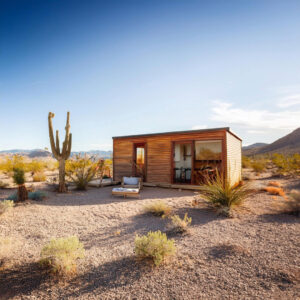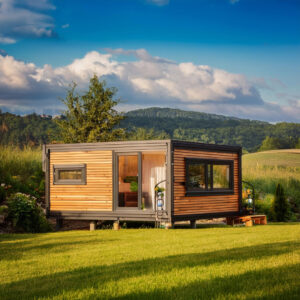The real estate market can be intimidating, especially for first-time investors. However, one of the most accessible and trending ways to break into the market is through tiny houses. Tiny houses offer an affordable, flexible, and sustainable option that can be both a personal residence and a lucrative investment. In this guide, we’ll explore why tiny houses are an excellent starting point for your real estate journey, how to build a tiny house, and the key considerations you need to know.
1. What is a Tiny House?
1.1. Definition of a Tiny House
A tiny house is a compact, typically 100 to 400 square feet, fully functional living space that includes all the essentials of a regular home. These homes prioritize efficient use of space and often feature innovative design elements to maximize utility.
1.2. Types of Tiny Houses
Tiny houses come in various forms, including:
- Tiny Houses on Wheels (THOWs): These are mobile homes built on trailers, offering the flexibility to move the house to different locations.
- Tiny Houses on Foundations: These are permanent structures built on a foundation, just like a traditional house but on a much smaller scale.
- Shipping Container Homes: These are tiny homes made from repurposed shipping containers, known for their durability and modern aesthetic.
1.3. The Growing Popularity of Tiny Houses
Tiny houses have gained popularity due to their affordability, sustainability, and minimalist lifestyle appeal. They are especially attractive to millennials, retirees, and those looking to downsize or live a more environmentally conscious life.
2. Why Start Your Real Estate Journey with a Tiny House?
2.1. Affordability
One of the main reasons tiny houses are an excellent starting point in real estate is their affordability. Traditional homes can be prohibitively expensive, especially in desirable areas. In contrast, tiny houses can be built or purchased for a fraction of the cost, making them accessible to more people.
2.2. Low Maintenance Costs
Tiny houses require less maintenance compared to larger homes. With less square footage to maintain, repair costs, utility bills, and cleaning efforts are significantly reduced, making tiny houses a cost-effective option.
2.3. Flexibility and Mobility
For those who choose a Tiny House on Wheels (THOW), the flexibility to move your home to different locations is a major advantage. Whether you want to explore different areas or simply avoid long-term commitments to one place, a tiny house offers mobility that traditional homes cannot.
2.4. Sustainability
Tiny houses are inherently more sustainable than larger homes. They require fewer materials to build, consume less energy, and often incorporate eco-friendly features such as solar panels, composting toilets, and rainwater collection systems.
2.5. Investment Potential
Tiny houses offer unique investment opportunities. They can be used as vacation rentals, long-term rentals, or even as a personal residence with the potential for future resale. The lower entry cost combined with the rising demand for unique, affordable housing options makes tiny houses an attractive investment.
3. How to Build a Tiny House: Step-by-Step Guide
3.1. Planning and Design
3.1.1. Set Your Budget
Before you begin building your tiny house, it’s crucial to establish a clear budget. Determine how much you can afford to spend, including costs for materials, labor (if you’re hiring help), and any permits or fees required by your local government.
3.1.2. Choose the Right Location
The location of your tiny house will impact your design choices and budget. If you’re building a Tiny House on Wheels, you’ll need to consider where you can legally park it. For a tiny house on a foundation, you’ll need to purchase land or build on existing property.
3.1.3. Design Your Tiny House
The design phase is where you can get creative. Work with a designer or use tiny house plans available online to create a layout that maximizes space and suits your needs. Consider key elements like:
- Space-saving features: Built-in furniture, lofted beds, and multipurpose areas.
- Sustainable design: Solar power, energy-efficient appliances, and sustainable materials.
- Personalization: Choose finishes, colors, and materials that reflect your style.
3.2. Securing Permits and Understanding Regulations
3.2.1. Zoning Laws and Building Codes
Before construction begins, it’s essential to understand the zoning laws and building codes in your area. These regulations can vary widely depending on your location, especially when it comes to tiny houses. Some areas have restrictions on the minimum size of dwellings, where they can be placed, and how they are used (e.g., as permanent residences or vacation rentals).
3.2.2. Permits
Securing the proper permits is critical to avoid legal issues. Depending on your location, you may need permits for construction, electrical work, plumbing, and more. Check with your local building authority to ensure you have all the necessary documentation.
3.3. Building Your Tiny House
3.3.1. Choose Your Building Method
You have two main options when building a tiny house:
- DIY (Do It Yourself): If you have construction experience or are willing to learn, building your tiny house yourself can save money and allow you to customize every detail.
- Hire a Builder: If you prefer a professional touch or don’t have the time or skills to build yourself, hiring a tiny house builder is a viable option. Many builders specialize in tiny houses and can offer custom designs.
3.3.2. Construction Process
The construction process involves several key steps:
- Foundation or Trailer: Depending on whether your tiny house will be stationary or mobile, you’ll need to either lay a foundation or secure a trailer.
- Framing: This is the skeleton of your tiny house, where the walls, roof, and floor come together.
- Insulation and Exterior: Proper insulation is crucial for energy efficiency. Choose materials that will keep your home comfortable in all seasons.
- Interior Finishes: Once the exterior is complete, you can focus on the interior, including flooring, cabinetry, and fixtures.
3.4. Utilities and Systems
3.4.1. Electrical Systems
Tiny houses can be wired for electricity just like a traditional home, whether you’re connected to the grid or using solar power. Plan your electrical system carefully to ensure it can handle your energy needs.
3.4.2. Plumbing
Tiny house plumbing can be traditional (connected to a municipal system) or off-grid (using tanks and pumps). Consider composting toilets, greywater systems, and other sustainable options to minimize your environmental impact.
3.4.3. Heating and Cooling
Tiny houses have unique heating and cooling needs due to their small size. Options include mini-split systems, wood stoves, and space heaters. Choose a system that fits your climate and budget.
3.5. Interior Design and Space Optimization
3.5.1. Multi-Functional Furniture
In a tiny house, every inch of space counts. Invest in multi-functional furniture like fold-out tables, sofa beds, and built-in storage to maximize your living area.
3.5.2. Storage Solutions
Storage is often a challenge in tiny houses. Utilize vertical space with shelving, under-bed storage, and lofted areas. Custom cabinetry and clever design tricks can make a small space feel much larger.
3.5.3. Aesthetic Considerations
Even though tiny houses are small, they don’t have to sacrifice style. Choose colors and materials that reflect your personality and create a comfortable, inviting atmosphere.
4. Financing Your Tiny House
4.1. Cost Breakdown
The cost of building a tiny house varies depending on factors like size, materials, and whether you build it yourself or hire a builder. On average, a DIY tiny house can cost between $10,000 and $30,000, while a professionally built tiny house can range from $30,000 to $100,000 or more.
4.2. Financing Options
4.2.1. Personal Loans
Many tiny house buyers use personal loans to finance their purchase. These loans typically have higher interest rates than traditional mortgages but are easier to obtain and can be used for any purpose.
4.2.2. RV Loans
If your tiny house is on wheels, you may qualify for an RV loan. These loans often have lower interest rates than personal loans and longer repayment terms.
4.2.3. Builder Financing
Some tiny house builders offer financing options directly to their customers. This can be a convenient way to finance your tiny house, especially if you’re purchasing a turnkey model.
4.2.4. Savings and Cash
If possible, paying for your tiny house with savings or cash is the best way to avoid debt and interest payments. This approach requires more upfront planning but offers long-term financial freedom.
4.3. Cost-Saving Tips
- DIY Construction: Building the tiny house yourself can save thousands of dollars.
- Recycled Materials: Using reclaimed or recycled materials can reduce costs and add character to your home.
- Buy Used: Consider buying used appliances, fixtures, and furniture to save money.
5. Legal Considerations
5.1. Zoning and Building Codes
Before you start building, it’s crucial to understand the zoning laws and building codes in your area. Some areas have minimum size requirements for dwellings, and others may not allow tiny houses at all. Research local regulations to ensure your tiny house is legal.
5.2. Parking and Land Use
If you’re building a Tiny House on Wheels, finding a place to park it can be challenging. Some areas have restrictions on where tiny houses can be parked, and others require special permits. Consider purchasing land, joining a tiny house community, or finding a host with available land.
5.3. Insurance
Insuring a tiny house can be more complicated than a traditional home, especially if it’s mobile. Look for insurance companies that specialize in tiny houses or RVs, and make sure you have adequate coverage for your home and belongings.
6. The Investment Potential of Tiny Houses
6.1. Tiny Houses as Rental Properties
One of the most popular ways to earn income from a tiny house is by renting it out. Tiny houses make excellent vacation rentals, especially in desirable locations. With platforms like Airbnb, you can easily list your tiny house and start generating rental income.
6.2. Resale Value
Tiny houses can retain their value well, especially if they are well-maintained and located in a desirable area. Some tiny houses even appreciate in value, making them a solid investment.
6.3. Expanding Your Tiny House Portfolio
Once you’ve successfully built and rented out your first tiny house, you might consider expanding your portfolio. Owning multiple tiny houses can generate significant passive income and diversify your real estate investments.
7. Success Stories: Real-Life Examples
7.1. Tiny House Pioneers
Many individuals have found success in the tiny house movement. From those who have built their dream homes for a fraction of the cost of traditional housing to investors who have turned tiny houses into profitable rental properties, the stories are inspiring.
7.2. Financial Independence Through Tiny Houses
For some, tiny houses have been the key to achieving financial independence. By reducing living expenses and generating rental income, tiny house owners have been able to pay off debt, save for retirement, and enjoy a more flexible lifestyle.
8. Conclusion
Starting your real estate journey with a tiny house is a smart, accessible way to enter the market. With their affordability, flexibility, and investment potential, tiny houses offer a unique opportunity for both personal and financial growth. Whether you’re looking to downsize, invest, or simply live a more sustainable lifestyle, tiny houses provide a versatile and rewarding option.
Learn how to built a Tiny house with step by step instructions guide


References
- The Tiny Life (2023). What is a Tiny House? Retrieved from thetinylife.com.
- Hutchison, A. (2019). The Complete Guide to Tiny Homes. Penguin Publishing Group.
- Forbes Real Estate Council (2023). The Financial Benefits of Tiny House Living. Retrieved from forbes.com.
- Kahn, D. (2021). Zoning and Legalities in the Tiny House Movement. University of California Press.
- Morrison, R. (2020). Tiny Houses as Real Estate Investments. Wiley Finance.



